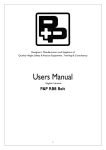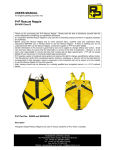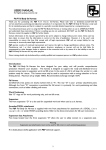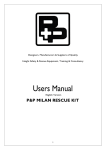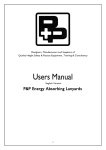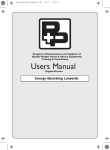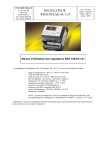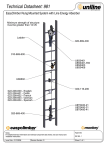Download online PDF manual
Transcript
V4 01/15 Designers, Manufacturers and Suppliers of Quality Height Safety & Rescue Equipment, Training & Consultancy P&P Slide Chuck Device / System User Instructions Thank you for purchasing this P&P Slide Chuck Device / System. Please take time to familiarize yourself with the correct use and operation. It is imperative that this device is only used for its intended purpose and that it is subject to a periodic recorded detailed inspection by a competent person. To avoid personal injury, prior to using this P&P Slide Chuck Device / System or training others to use it, CAREFULLY READ and understand these instructions. If there is anything you do not understand, DO NOT use the P&P Slide Chuck Device / System, contact the supplier or P&P for further details. Certain information in this manual is governed by law and is subject to change without prior notice. Great care has been taken to ensure the information is correct at the time of publication. However, it is the user’s sole responsibility to ensure that they fully comply with all legal requirements. P&P will not accept liability for any inaccuracy or incorrectly stated legal requirements. P&P operate a policy of continual improvement and reserve the right to change specifications without notice. The Manufacturer and / or their recognised agents, directors, employees or insurers will not be held liable for consequential or other damages, losses or expenses in the connection with or by reason of or the inability to use the P&P Slide Chuck Device / System for any other purpose. Description A vertical fall arrest system which travels smoothly up and down 16mm diameter nylon or polyester rope. The system gives vertical freedom of movement, but locking automatically in the event of a slip or fall. The system comprises the device with a connector or the device with a “Chunkie” energy absorber and connector. 4. Check that locking pin has fully returned and the catch lever has returned to lock off the guide slot. Warning All work at height including the use of Personal Protective Equipment (PPE) as a control measure is subject to a suitable and sufficient risk assessment. Operation Product Conformance Standard Rope Type Unit Weight Temperature Range EN353-2 16mm 3 strand hawser laid nylon rope 0.45Kg -30C to 50C Fitting the Slide Chuck Device onto 16mm Diameter Rope 1. Hold the device body in one hand, with the up arrow uppermost. 2. Press the catch on the side of the device marked ‘PUSH’ and pull the pin at the bottom of the device downwards. This will release the biting cam. 3. Place rope in the rope guide channel and reverse the procedure to captivate rope into the device. Hold the cam up while this procedure is being carried out. The arrow with the word “UP” must be pointing up the rope away from the ground, skyward. Use only with 16mm diameter nylon or polyester rope conforming to the requirements of EN353-2 and P&P compatible harnesses. Before ascending, check that the Slide Chuck arrests by sharply pulling the lever or the connecting lanyard downwards, towards the ground. The Slide Chuck should grip the rope and hold a person’s weight without slippage. The rope anchorage point should have a professionally spliced eye and karabiner connector conforming to EN362. The other end must be spliced or securely knotted to prevent the Slide Chuck coming off the bottom of the rope. The anchor rope should be reasonably taut. When in working position, park the Slide Chuck as far above the harness attachment point as is practical. When descending reposition Slide Chuck down the rope by lifting lever. Do NOT disconnect to do this. NOTE: The Slide Chuck has a cam, which prevents operation of this device when inverted. If the device is inverted then the catch marked ‘PUSH’ cannot be pressed and hence the pin cannot be pulled to release the biting cam. This is a safety feature. ALTHOUGH THIS SYTEM OF WORKING ALLOWS LATERAL AS WELL AS VERTICAL MOVEMENT, PLEASE BE AWARE OF “THE PENDULUM EFFECT” IE SWINGING FROM SIDE TO SIDE IN THE EVENT OF A FALL. BE AWARE OF PROTRUSIONS OR OBSTACLES. P&P Limited, 131 New John Street, Aston, Birmingham B6 4LD England Tel: +44 (0)121 359 4561 Fax: +44 (0)121 359 4136 e-mail: [email protected] website: www.ppsafety.co.uk Registered in England No. 01493537 Important Prior to use, a full visual inspection of every part of the fall arrest system must be carried out by the user as detailed in this P&P user manual. This fall arrest system is for personal use only. Only use connectors (hooks, karabiners etc.) approved and recommended by P&P. Check the inspection record for this lanyard to ensure that regular inspections have been correctly recorded. It is strongly recommended that the user is given adequate practical training prior to using this device/system or any other P&P product. DO NOT use this device/system until you have read and fully understood these instructions. silicon based lubricant. Do NOT allow lubricant on the surface of the rope channel or serrated grab face. Nylon and polyester ropes are made from synthetic fibre. Nylon is resistant to alkalis whereas polyester is resistant to mild acidity and alkalis. Ordinary grime can be removed with soap and water or other mild detergents. Wipe dry and allow drying naturally away from a direct source of heat. In case of severe soiling, please contact your supplier or P&P. Store in a cool, dry place away from direct heat or sunlight and any contact with corrosive elements, chemicals or sharp edges. Rescue Plan As part of your risk assessment you MUST have in place a rescue plan to deal with any emergency, which may occur during use. Access to the user, directly or indirectly and their safe retrieval is of paramount importance, including preparations for dealing with potential Post Fall Suspension Syncope Chemical Attack IF IN DOUBT, CHECK BACK WITH THE SUPPLIER OR P&P. Modifications and Repairs No repairs, modifications or alterations are to be carried out on this P&P Slide Chuck Device / System. Inspection Always make sure the product label is present showing both the serial number and date of manufacture and that it matches your User Manual. If the numbers are not legible on the Product Label or do not match the User Manual – DO NOT USE the device / system! The device / system, along with all your other safety equipment must be subjected to a pre-use check, each time before use. Failure to inspect the device / system correctly could cost you your life. You should be trained to carry out a pre-use check. Detailed Recorded Inspections should only be carried out by a trained, competent person, appointed by the employer. Additionally, recorded interim inspections may be required where risks from transient arduous working environments exist. This should be identified through Risk Assessment. These recorded inspections must be carried out at least every 12 months as a requirement of EN365, however; in the UK the HSE would like to see all Fall Protection PPE have a Detailed Recorded Inspection every 6 months. The pre-use check must include (but is not limited to): • Check all webbing / rope for signs of cuts, abrasions, fraying, tears, burns, mould, discolouration or chemical attack. • Check all stitching for signs of loosening, pulling or cut thread. There must be no evidence of damaged stitching on either side of the stitch pattern. • If the device / system has been subject to significant paint overspray, it must not be used. • Adjusters and connectors MUST be free from rust, excessive wear, distortions or cracks. If during the pre-use check any part is found to be or believed to be faulty. DO NOT use it. Remove ALL components from site to ensure that they cannot be use by anyone. Cleaning, Maintenance and Storage Brush out any foreign matter, dirt, grit, mud etc. Lubricate moving parts lightly once a month or more frequently if used in harsh conditions, with Avoid contact with any chemical, which might affect the performance of this product, e.g these include all acids and strong caustic substances (vehicle battery acid, bleach etc) If subject to chemical attack, you must remove it from service and check with P&P for advice on the possible consequence of chemical degradation. Marking of PPE Textile products including webbing and rope must not be marked using ink or paint. Marker pens and paint will contaminate textile fibres leading to potential damage from material stiffening or even chemical attack. Plastic or Metal casings of components must not be marked by stamping, etching or engraving. These processes may weaken the material or damage protective coatings. P&P advise that if additional identification is required a tagging system (label or electronic) should be used, that does not interfere in any way with the operation of equipment or devices. Contact P&P or your supplier for advice on additional labelling. Service Life Textile materials including ropes have a service life of 5 years. See following obsolescence statement. Warning This P&P Slide Chuck Device / System must be used by persons who are medically fit to do so. If you have any medical condition, are recovering from any medical condition or suffer from any physical or mental disability you must seek professional medical advice before using this rescue system. Obsolescence A new item of textile Fall Protection Equipment manufactured by P&P Limited may be stored for a maximum of 3 years and will still give the potential 5 year working life provided it remains in the original manufacturer's packaging. Once the product is taken from this original packaging for the first time, this date becomes the ‘date of first use’, which should be recorded on the Inspection Record and the 5 year working life begins. Keep these instructions or a copy with the P&P Slide Chuck Device / System for future reference to assist with inspections and safety checks. P&P Limited, 131 New John Street, Aston, Birmingham B6 4LD England Tel: +44 (0)121 359 4561 Fax: +44 (0)121 359 4136 e-mail: [email protected] website: www.ppsafety.co.uk Registered in England No. 01493537







